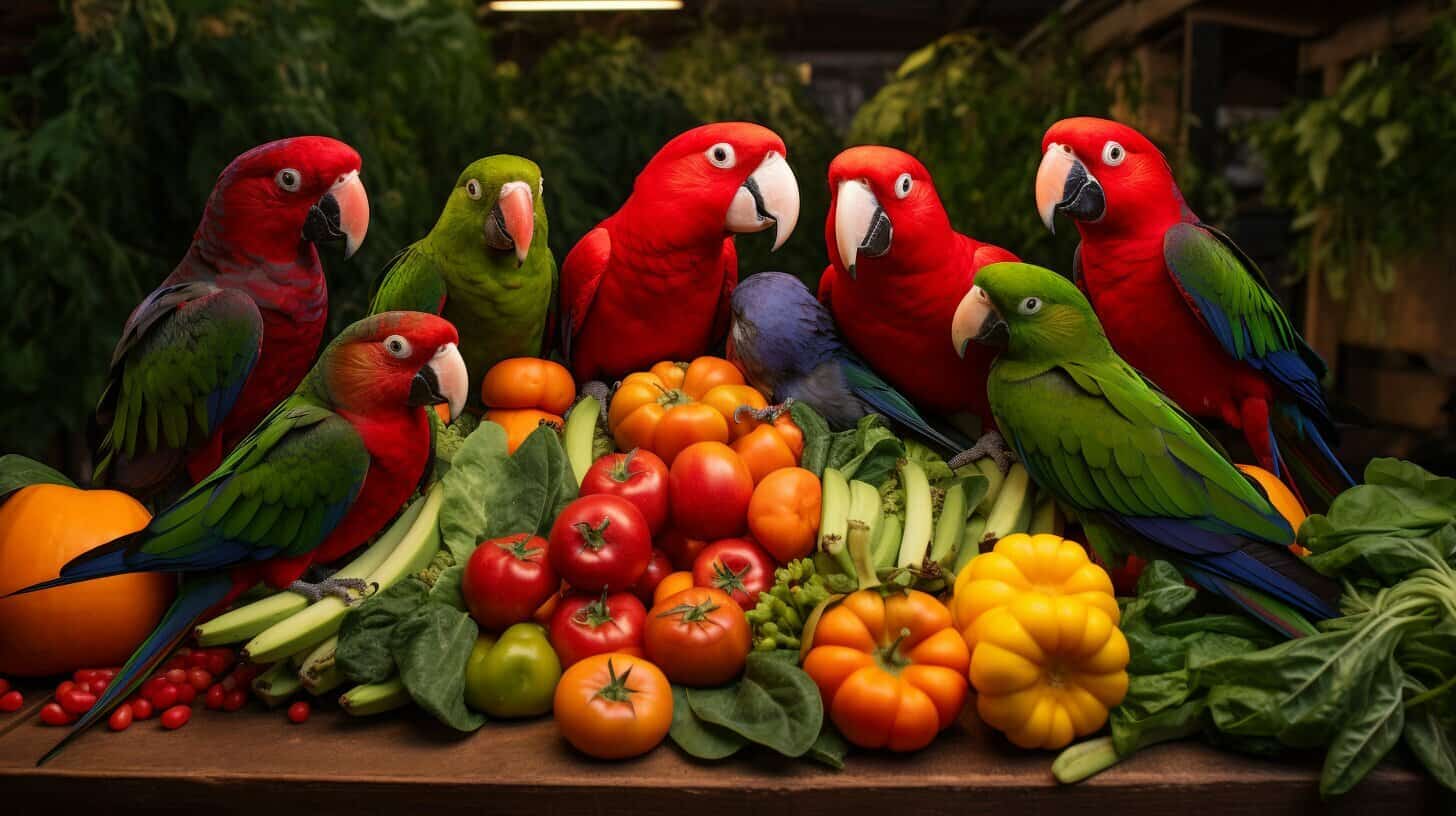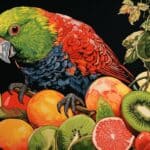Kakarikis are popular pet birds due to their friendly and playful nature. Responsible owners must provide a healthy and balanced diet to meet their nutritional needs. Vegetables are essential to a kakariki’s diet, providing numerous health benefits. However, not all vegetables are safe for Kakarikis to consume, and knowing what vegetables Kakarikis can eat is crucial.
This article will provide a comprehensive guide on what vegetables kakarikis can eat. It will highlight the benefits of incorporating vegetables into their diet and provide them with a list of safe vegetables. It will also discuss the importance of offering a variety of vegetables and how to prepare them for the birds.
Key Takeaways:
- Kakarikis need a balanced and nutritious diet to maintain their health and well-being.
- Vegetables are essential to their diet as they provide numerous health benefits.
- Not all vegetables are safe for kakarikis to consume, and it’s crucial to know which ones suit their consumption.
The Importance of a Balanced Diet for Kakarikis
Kakarikis are playful and energetic birds that require a well-balanced diet to maintain their health and vitality. A vegetable-rich diet is essential for their overall well-being, as it helps them meet their nutritional requirements and prevents deficiencies that can lead to health issues.
Feeding kakarikis a vegetable-rich diet also helps to promote good digestive health and can prevent obesity, as vegetables are low in calories and fibre. Furthermore, a balanced diet can help to prevent common health problems such as fatty liver disease, vitamin deficiencies, and metabolic disorders.
It is crucial to note that a diet consisting solely of vegetables is not adequate for Kakarikis, as they require various nutrients from other food sources. Therefore, it is essential to supplement their vegetable diet with other suitable food items such as fruits, seeds, and pellets to ensure they receive a complete and balanced nutritional intake.
Safe Vegetables for Kakarikis
Kakarikis have a diverse palate, and offering them a variety of vegetables can help ensure a balanced and nutritious diet. However, not all vegetables are safe for these birds to consume. Here is a list of vegetables that are suitable and safe for kakarikis to eat:
| Vegetable | Nutritional Value | Benefits |
|---|---|---|
| Broccoli | High in vitamins C and K, fiber, and potassium | Helps support a healthy immune system and promotes strong bones |
| Carrots | High in beta-carotene, fibre, vitamins A, K, and B6, and potassium | Promotes healthy vision and skin, and supports a healthy immune system |
| Cauliflower | High in vitamins C and K, fiber, and potassium | Helps support a healthy immune system and promotes strong bones |
| Corn | High in fibre and antioxidants | Supports digestive health and may help reduce the risk of certain diseases |
| Green beans | High in fibre vitamins C and K, and folate | Helps support a healthy immune system and promotes healthy skin and bones |
| Kale | High in vitamins C and K, fibre and calcium | Promotes strong bones and healthy vision, and supports a healthy immune system |
| Peppers | High in vitamins C and A, fibre, and potassium | Supports healthy vision and immune system, and promotes healthy skin and bones |
| Sweet potato | High in fibre, vitamins A and C, and potassium | Supports healthy vision, immune system, and overall heart health |
| Zucchini | High in vitamin C, fibre, and potassium | Supports healthy digestion and immune system, and promotes healthy skin and bones |
It is important to note that these vegetables should be served in small amounts, as part of a balanced diet that includes other food sources. Owners should also monitor their birds’ response to each vegetable and adjust as needed to ensure a healthy and happy pet.
Incorporating Variety in Kakariki’s Vegetable Diet
Offering a variety of vegetables to kakarikis is essential to ensure that they receive a diverse range of nutrients. Rotating the vegetables given to the birds is recommended to provide them with a balanced diet. Owners can adjust the vegetables according to the season, availability, and their birds preference.
Here are some vegetables that are recommended for kakarikis:
By incorporating different vegetables in their diet, owners can prevent their kakarikis from becoming bored with the same food and ensure they receive a variety of nutrients necessary for their well-being.
The Importance of Properly Preparing Vegetables for Kakarikis
Feeding vegetables to kakarikis is an excellent way to ensure they receive the necessary vitamins and nutrients to maintain a healthy diet. However, it is imperative to prepare the vegetables properly to avoid any potential health risks.
Before feeding the vegetables to the birds, it is important to wash them thoroughly to remove any harmful chemicals or pesticides. Avoid using detergents or soaps, as they can harm the birds.
Removing any seeds or pits from the vegetable is recommended, as they can cause blockages in the bird’s digestive system. Cutting the vegetables into small, bite-sized pieces is also essential to make it easier for the birds to eat and digest them.
When offering vegetables to kakarikis, it is crucial to provide them in moderation. Too much of any one type of vegetable can cause an imbalance in their diet and lead to health issues. Monitoring their vegetable intake and adjusting accordingly is essential to ensure a balanced diet.
Finally, presentation is important when feeding vegetables to kakarikis. It is recommended to offer the vegetables differently, such as chopped or grated and presented in various forms like skewers, bowls, or hiding them in foraging toys. Offering vegetables in different ways will encourage the birds to eat them and add variety to their diet.
The Importance of Monitoring and Adjusting the Vegetable Intake
While incorporating vegetables into a kakariki’s diet is essential, monitoring their intake and making adjustments as needed is equally important. As with any dietary change, it’s important to observe the bird’s response to different vegetables and adjust the diet accordingly.
A general guideline is to initially offer vegetables in small portions and gradually increase the quantity over time. This allows the bird’s digestive system to adjust to the new food items and helps prevent potential digestive issues.
Owners should also pay attention to signs indicating the need for dietary modification. For example, if the bird is not consuming the vegetables offered or experiencing digestive discomfort, adjusting the vegetable selection or portion sizes may be necessary.
Furthermore, the amount of vegetables offered should vary depending on the bird’s needs and dietary requirements. Age, activity level, and overall health should be considered when determining the appropriate vegetable intake.
In summary, monitoring and adjusting vegetable intake is crucial in ensuring a healthy and balanced diet for kakarikis. Owners should observe their bird’s response to different vegetables, adjust their diet, and consider their needs and requirements.
The Vegetables to Avoid for Kakarikis
While vegetables are an important part of a kakariki’s diet, some should be avoided due to their potential toxicity or harmful effects. Owners should be aware of these vegetables to ensure the safety and well-being of their birds.
| Vegetable | Reason to Avoid |
|---|---|
| Avocado | Contains persin, which can be toxic to birds and cause heart and respiratory problems |
| Tomato Leaves and Stems | Contain solanine, which can be toxic to birds and cause digestive problems |
| Onion and Garlic | Contain thiosulphate, which can lead to the destruction of red blood cells and cause anaemia |
| Raw Beans | Contain hemagglutinin, which can interfere with digestion and lead to vomiting and diarrhea |
| Rhubarb Leaves | Contain oxalic acid, which can be toxic and cause kidney failure |
It is important to note that these vegetables should not be fed to kakarikis in any form, including cooked or processed. Owners should always double-check the safety of a vegetable before offering it to their birds to avoid any potential harm.
Incorporating Variety in Kakariki’s Vegetable Diet
While it’s important to have a few staple vegetables in a kakariki’s diet, incorporating a variety of vegetables is essential to ensure a well-rounded nutritional intake. Rotating different vegetables also helps to keep the bird’s diet interesting and prevents boredom.
Here are some recommended vegetables to rotate in a kakariki’s vegetable diet:
| Vegetable | Nutritional Benefits |
|---|---|
| Carrots | High in vitamin A for healthy eyesight and skin. |
| Broccoli | Rich in vitamin C and calcium for healthy bones and immune system. |
| Kale | Loaded with vitamin K, iron, and antioxidants. |
| Spinach | High in iron and vitamin K for healthy blood and bones. |
| Peppers | Rich in vitamin C for a strong immune system and healthy skin. |
| Pumpkin | High in vitamin A and beta-carotene for healthy eyesight and immune system. |
Remember to wash all vegetables thoroughly to remove pesticides or harmful substances before offering them to the bird. It’s also important to introduce new vegetables slowly to monitor how the bird responds to them.
By rotating different vegetables, owners can ensure their kakarikis get a diverse and well-balanced diet to promote their overall health and well-being.
Conclusion
Feeding your kakariki a healthy and balanced diet is essential for maintaining their health and well-being. Vegetables are a crucial component of their diet and provide a variety of essential nutrients and vitamins.
It is important to have a diverse range of vegetables in their diet and other suitable food items, such as fruits and pellets. By offering a variety of vegetables and supplements, you can ensure that your kakariki receives a well-rounded nutritional intake.
When introducing new vegetables, monitoring their response and adjusting their diet as needed is important. Always wash and remove any harmful substances from the vegetables before feeding them to your kakariki, and offer them in appropriate portion sizes.
Remember to avoid feeding your kakariki vegetables that are toxic or harmful to their health. A comprehensive list of safe and suitable vegetables for kakarikis has been provided in this guide to help you make the best food choices for your bird.
Following these guidelines and incorporating vegetables into your kakariki’s diet can help ensure they live healthy and happy life.
FAQ
Q: What vegetables can kakarikis eat?
A: Kakarikis can safely eat various vegetables, including but not limited to broccoli, carrots, spinach, kale, peas, and bell peppers. It’s important to ensure that the vegetables are fresh and pesticide-free before offering them to your kakariki.
Q: Why is a balanced diet important for kakarikis?
A: A balanced diet is crucial for kakarikis’ health and vitality. It provides them with essential nutrients and helps prevent nutritional deficiencies. Incorporating vegetables in their diet ensures they receive the necessary vitamins, minerals, and fibre for their well-being.
Q: What are some safe vegetables for kakarikis?
A: Besides the aforementioned vegetables, some other safe options for kakarikis include cucumber, zucchini, sweet potatoes, and Brussels sprouts. Remember to introduce new vegetables gradually and observe their response to ensure they tolerate them well.
Q: How can I incorporate variety in my kakariki’s vegetable diet?
A: To incorporate variety, you can rotate vegetables throughout the week. This helps provide a diverse range of nutrients and prevents boredom. You can also offer a mix of raw and cooked vegetables to vary the textures and flavours.
Q: How should I prepare vegetables for my kakariki?
A: It’s crucial to prepare vegetables for your kakariki properly. Wash them thoroughly to remove any pesticides or harmful substances. Cut them into small, manageable pieces and ensure they are soft enough for your bird to chew. Serve the vegetables fresh and remove any uneaten portions after a few hours.
Q: How can I monitor and adjust my kakariki’s vegetable intake?
A: Keep an eye on your kakariki’s response to different vegetables. If they show disinterest or digestive issues, try offering different options or adjusting the portion sizes. Additionally, consult with a veterinarian experienced in avian care for personalized guidance.
Q: Are there any vegetables to avoid for kakarikis?
A: Yes, certain vegetables can be harmful to kakarikis. These include avocado, onion, garlic, and rhubarb. These vegetables can be toxic or cause digestive problems for your kakariki, so it’s best to avoid them completely.
Q: Should I supplement my kakariki’s vegetable diet?
A: While a vegetable-rich diet is important, it’s also beneficial to supplement your kakariki’s diet with other suitable food items. This can include fruits, such as apple or banana, or commercially available pellets formulated for kakarikis. Consult with your avian veterinarian for specific recommendations.



Have comments or questions about this article? Then get involved!
Spotted an error or something we have missed? Let us know